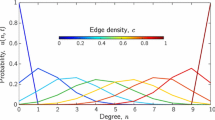Abstract
We study the efficiency of the incomplete enumeration algorithm for linear and branched polymers. There is a qualitative difference in the efficiency in these two cases. The average time to generate an independent sample of configuration of polymer with n monomers varies as n 2 for linear polymers for large n, but as exp(cn α) for branched (undirected and directed) polymers, where 0<α<1. On the binary tree, our numerical studies for n of order 104 gives α = 0.333±0.005. We argue that α =1/3 exactly in this case.
Similar content being viewed by others
Change history
03 August 2005
An Erratum to this paper has been published: https://doi.org/10.1007/s10955-005-3648-2
06 November 2023
A Correction to this paper has been published: https://doi.org/10.1007/s10955-023-03197-1
References
A. D. Sokal, Monte-Carlo Methods for the Self Avoiding Walk 1995, in Monte Carlo and Molecular Dynamics Simulations in Polymer Science, K. Binder, ed. Oxford University Press New York 47–124, hep-lat/9405016.
M. Doi S.F. Edwards (1986) The Theroy of Polymer Dynamics Clarendon Press Oxford
F.T. Wall F. Mandel (1975) ArticleTitleMacromolecular dimensions obtained by an efficient Monte Carlo method without sample attrition J. Chem. Phys 63 4592–4595 Occurrence Handle10.1063/1.431268
N. Madras A.D. Sokal (1988) ArticleTitleThe pivot algorithm: A highly efficient Monte Carlo Method for the self-avoiding walk J. Stat. Phys 50 109 Occurrence Handle10.1007/BF01022990
S. Caracciolo A. Pelissetto D. Sokal A. (1990) ArticleTitleA nonlocal Monte Carlo algorithm for self-avoiding walks with fixed endpoints J. Stat. Phys 60 1 Occurrence Handle10.1007/BF01013668
F.T. Wall J.J. Erpenbeck (1959) ArticleTitleNew method for the statistical computation of polymer dimensions J. Chem. Phys 30 634–637 Occurrence Handle10.1063/1.1730021
P. Grassberger and W. Nadler, “Go with the winners – Simulations, cond-mat/0010265”, Proc. der Heraeus-Ferienschule “‘Vom Billiardtisch bis Monte Carlo: Spielfelder der statistischen Physik”’, (Chemnitz, October 2000).
E.J. Jansevan Rensburg S.G. Whittington N. Madras (1990) ArticleTitleThe pivot algorithm and polygons: Results on the FCC lattice J. Phys. A 23 1589
T. Kennedy (2002) ArticleTitleA faster implementation of the pivot algorithm for self-avoiding walks J. Stat. Phys 106 407–429 Occurrence Handle10.1023/A:1013750203191 Occurrence HandleMR1884540
A. Berreti D. Sokal A. (1985) ArticleTitleNew Monte Carlo method for self-avoiding walk J. Stat. Phys 40 483 Occurrence Handle10.1007/BF01017183
E. J. Janse van Rensburg, and N. Madras, A nonlocal Monte Carlo algorithm for lattice trees, J. Phys. A:Math. Gen. 25:303–333 (1992); Metropolis Monte Carlo simulation of lattice animals, J. Phys. A:Math. Gen. 30:8035-8066 (1997); E. J. Janse van Rensburg and A. Rechnitzer, High precision canonical Monte Carlo determination of the growth constant of square lattice trees, Phys. Rev E 67:0361161–0361169 (2003).
S. You E.J. Jansevan Rensburg (2001) ArticleTitleAdsorbing trees in two dimensions: A Monte Carlo study Phys. Rev. E 64 0461011–0461019 Occurrence Handle10.1103/PhysRevE.64.046101
H. P. Hsu, W. Nadler, and P. Grassberger, Simulations of lattice animals and trees, cond-mat/0408061 (2004).
S. Redner P.J. Reynolds (1981) ArticleTitlePosition-spae renormalisation group for isolated polymer chains J. Phys. A 14 2679
D. Dhar P.M. Lam (1986) ArticleTitleMonte Carlo method for series expansions J. Phys. A: Math. Gen 19 L1057–1061 Occurrence Handle10.1088/0305-4470/19/17/002
P.M.. Lam (1986) ArticleTitleMonte Carlo study of lattice animals in d dimensions Phys. Rev. A 34 2339–2345 Occurrence Handle10.1103/PhysRevA.34.2339 Occurrence Handle9897522
J. L. Martin, Computer Techniques for Evaluating Lattice Constants, Phase Transitions and Critical Phenomena, C. Domb and O. M. Green, eds. (vol. 3, Academic Press London, 1983).
T.E. Harris (1963) of Branching Processes Springer-Verlag Berlin
G. Grimmett (1989) Percolation Springer-Verlag Berlin
N. Madras G. Slade (1993) The Self Avoiding Walk Birkhauser Boston
B. Nienhuis (1982) ArticleTitleExact critical point and critical exponents of O(n) models in two dimensions Phys. Rev. Letts 49 1062 Occurrence Handle10.1103/PhysRevLett.49.1062
I Jensen.and A.J Guttmann., Self-avoiding polygons on the square lattice, cond-mat/9905291, (1999).
R. P.Stanley , Enumerative Combinatorics, (Vol.2, Chapter 6, Cambridge University Press, Cambridge, New York, 1999).
W.V. Saarloos (2003) ArticleTitleFront propagation into unstable states Phys. Rep 386 29 Occurrence Handle10.1016/j.physrep.2003.08.001
E. Brunet and B. Derrida, Shift in the velocity of a front due to a cutoff, Phys. Rev. E 56: 2597 (1997); S. N. Majumdar and P. L. Kaprivsky, Extreme value statistics and travelling fronts: Various applications, Physica A 318:161 (2003).
I. Jensen (2001) ArticleTitleEnumerations of lattice animals and trees J. Stat. Phys 102 865–881 Occurrence Handle10.1023/A:1004855020556
K. Barat B.K. Chakrabarti (1995) ArticleTitleStatistics of self-avoiding walks on random lattices Phys Rep 258 377 Occurrence Handle10.1016/0370-1573(95)00009-6
Author information
Authors and Affiliations
Corresponding author
Rights and permissions
About this article
Cite this article
Sumedha, Dhar, D. Efficiency of the Incomplete Enumeration Algorithm for Monte-Carlo Simulation of Linear and Branched Polymers. J Stat Phys 120, 71–100 (2005). https://doi.org/10.1007/s10955-005-5462-2
Received:
Accepted:
Published:
Issue Date:
DOI: https://doi.org/10.1007/s10955-005-5462-2




